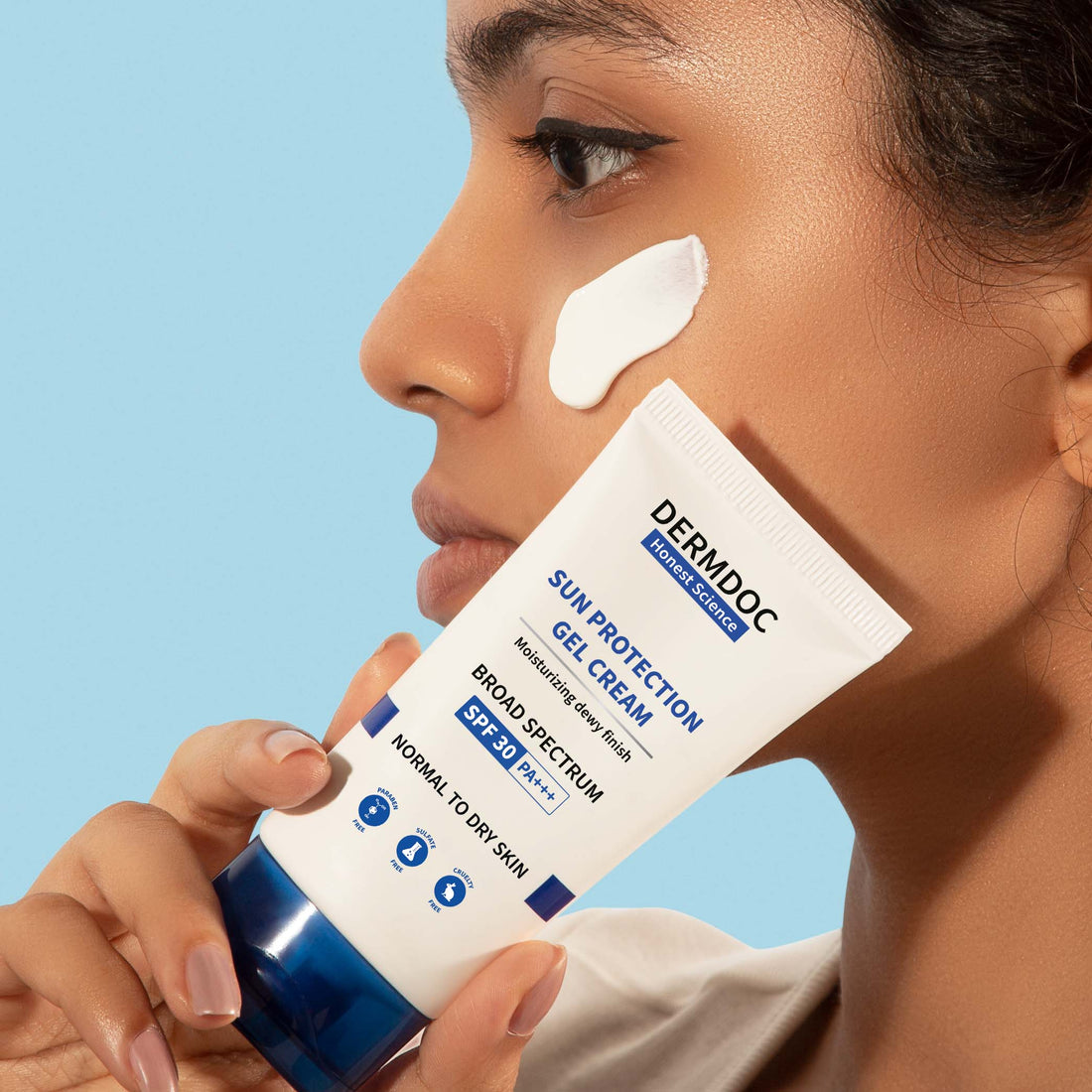Should I apply sunscreen at home?
If I do, how to reapply sunscreen?
And forget that, how do I apply physical sunscreen?
When you're just beginning your skincare journey, sunscreen can seem to be the most confounding of problems. But DermDoc is here to demystify this conundrum for you.
Before we get to how to correctly apply sunscreen, let's first get to finding the right sunscreen for you.
Not every skin is born the same. All expensive sunscreen is not good. Similarly, cheap sunscreen doesn't mean bad sunscreen. Let's quickly run through some great Dermdoc products review for sunscreen before we get to how to correctly apply sunscreen.
Does Cheap Sunscreen Equal Bad Sunscreen?
The short answer is -- NO! Let's take a look at some great sunscreen options to suit your skin type.
1. DermDoc by Purplle UVA & UVB Broad Spectrum Sun Protection Gel Cream With SPF 50 & PA+++
This sunscreen isn't too greasy or too matte. It has a moisturising dewy finish and a soft fragrance. It is also easily spreadable without a white cast, and at the price of INR 275 per pack, it's one of the cheapest sunscreen options out there.
2. DermDoc by Purplle UVA & UVB Broad Spectrum Sun Protection Gel Cream With SPF 30 & PA+++
How to apply physical sunscreen might be difficult for a lot of users to understand, but this DermDoc by Purplle sunscreen makes it easy. It’s great for normal to dry skin and is therefore one of the more moisturising options out there. This is a cheap sunscreen that gives the skin a glow and doesn't have a high white cast, which is a common problem when it comes to physical sunscreens.
Now coming to the meat of the matter, let's make it easy for you with some simple step-by-step instructions that will surely help you in your skincare journey.
-
Make sure your face is clean and dry

You want to begin with a blank canvas, always. Assuming you don’t have any makeup on yet, a simple cleanse will do– use your favourite cleanser or just water, anything is fine, but make sure there is no dirt that can get trapped under a thick layer of SPF and clog your pores.
After cleansing your face, pat it dry with a gentle cloth, like a cotton towel.
- Spread 2 fingers’ worth of sunscreen out
Now here is the tricky part. How much sunscreen is enough sunscreen? How much sunscreen is too much sunscreen? Well, while the medical world likes being fickle, the standard answer that skincare experts follow is this: Two fingers’ worth! This will look a little like this:

Now this may seem like a lot, but trust the experts when we say your skin needs the SPF! You won’t be complaining about it when you’re in your eighties and your skin looks like a baby’s bottom.
-
Blend!
This is more applicable to physical sunscreen as compared to chemical sunscreens. They tend to leave a bit of whitecast due to the nature of the SPF blockers used. This is why it’s important to blend it properly, but make sure to be gentle. After all, it’s your skin under there!

-
Reapply
The biggest misstep that most users commit is probably not reapplying their sunscreen. This is vital as SPF gets rubbed off throughout the day. In the case of sunscreen, it might be worth it to not keep your hands to yourself (looking at you, Selena Gomez)!
Now, this process might seem fairly simple, but there might be some doubts you have, like ‘Should I apply sunscreen at home?’, ‘How should I reapply sunscreen?’, ‘How do I apply physical sunscreen?’ Don’t worry, we will make sure your questions are answered.
-
Double Cleanse
This is applicable to physical sunscreen users: Because of the type of blockers that physical sunscreen uses, there is a higher chance of getting your pores blocked if not cleansed properly, especially if you have sensitive skin. But don’t worry, there is an easy fix to this– something that is a good skincare practice any which way– double cleansing!

Double cleansing helps clear your pores of any trapped residue from makeup, dirt or other outside elements thoroughly. It involves washing your face first with an oil-based cleanser (this could even be a wax, actual essential oil or micellar water) followed by a water-based cleanser that is gentle on the skin.
We can probably add another point talking about properly taking it off at night through double cleansing since not washing off SPF etc correctly at the end of the day can lead to clogged pores. Your call if you think this section is relevant.
Should I apply sunscreen at home?
Simple answer: yes.
Now, if you want the longer cut, here’s why:
The way sunscreen works is by blocking out the ultraviolet rays that are harmful for your skin. These rays are the ones that accelerate the skin’s natural ageing process, make issues like acne and hyperpigmentation much worse, and even trigger life-threatening diseases like skin cancer.
The ultraviolet rays (UV) are blocked by something called UV-A and UV-B blockers. They are what makes sunscreen, well, a screen or a shield against the sun.

When you are sitting indoors, you might not think that you need sunscreen at all, but have you ever noticed how strong the sun feels on your skin when you’re sipping that warm cup of coffee on a cold winter morning next to your favourite window? Well, unfortunately, the UV rays carry that same strength all year round, even though you may not directly feel it. And worst of all, the windows do nothing to hinder their effects on your long-term skin health. The only way to protect yourself is to either keep the curtains drawn 24x7, wear full-length clothing that leaves no patch of skin uncovered, or use sunscreen.
We certainly think sunscreen is the more pleasant of the two options.
Also, applying sunscreen is ultimately a matter of discipline, the same as showering every day or working out. You have to eventually build it up to when it is a habit, not something that you do because it’s sunny outside (fun fact– you have to apply sunscreen even when it’s cloudy because yes, you guessed it! UV rays penetrate clouds too).
If you don’t believe us, believe science.
American Bill McElligot was 69 when interviewed by the New England Journal of Medicine, at which point he had spent 28 years driving trucks for a living. He never applied sunscreen a single day in his life. The right side of his face was consistently exposed to the sun through the truck window directly next to the driver’s seat whereas his left side wasn’t as exposed in comparison.
After almost 3 decades, this is how his face ended up looking:

No offence to Bill, but I’m sure none of us want to end up in similar circumstances. So, yes, use that sunscreen– even indoors!
How do I apply physical sunscreen?
Before we get to that, you need to understand the science behind physical sunscreen.
Physical sunscreen is also known as mineral sunscreen. The reason why it’s called physical sunscreen is a two-parter: first, it physically blocks the UV rays by reflecting them away from the skin, kind of like a trampoline off of which the UV rays bounce off.
Physical sunscreen also is much thicker and gloopier than chemical sunscreen, which is why it often tends to leave a little bit of a whitecast unless it’s blended well. It also has to be removed at the end of the day using a double cleanse, otherwise, if you have sensitive skin, you might end up getting your pores blocked!
Now how do you apply it?

Well, exactly how you apply chemical sunscreen. Spread two fingers’ worth and blend like it’s foundation! But remember to always double cleanse at the end of the day, and reapply reapply reapply!
Hopefully, this article helped you gain some clarity on how to correctly apply sunscreen, and maybe you learned something new today! Check out our blog for more.

